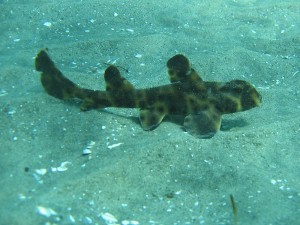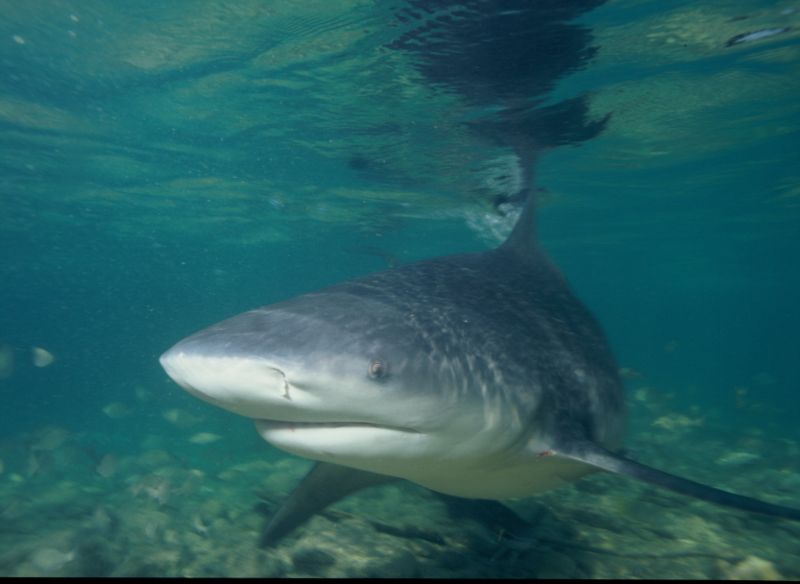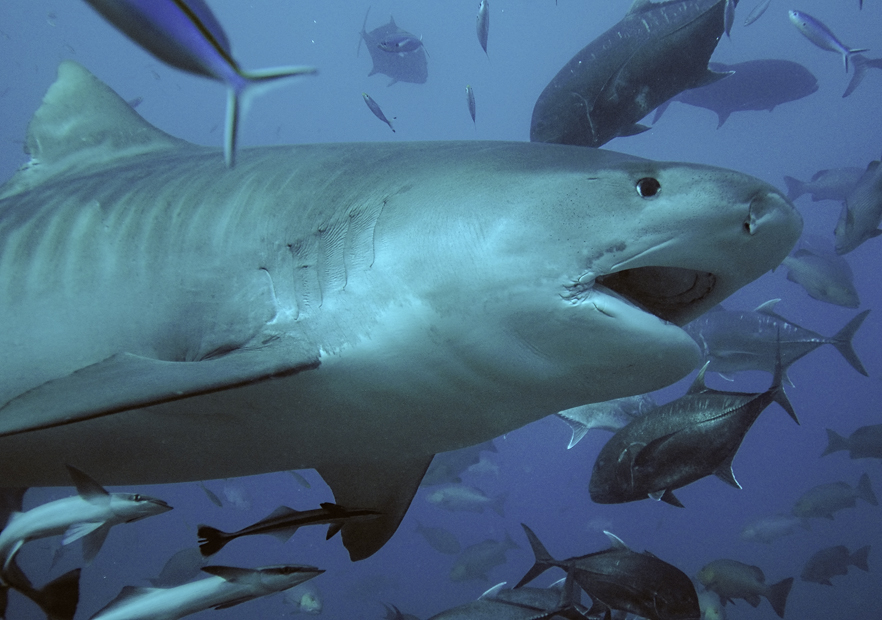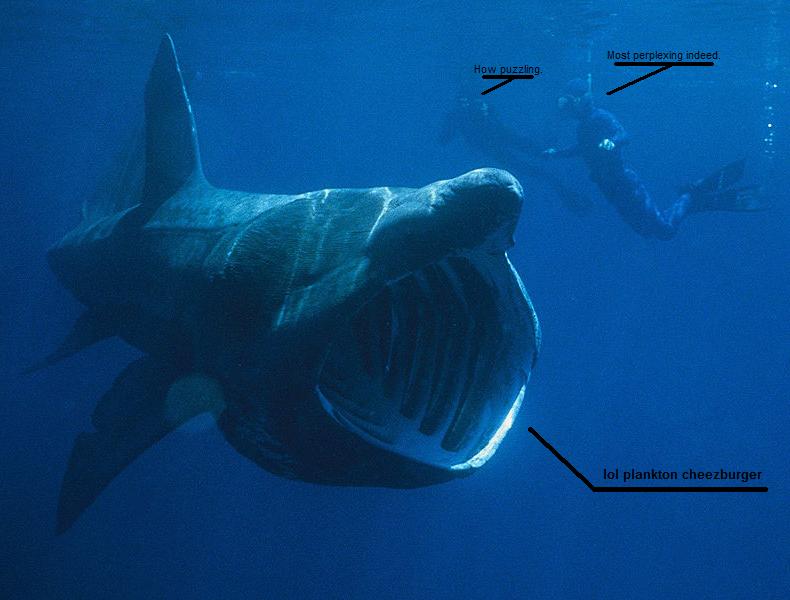Seeing as the ocean is the largest environment on earth, and the one that we’re the least adapted for, it follows that we’re a bit naturally skittish of it and the things that live inside it, particularly its bigger predators. Not only are they possessed of pointy teeth and the natural inclination to put them to gruesome purposes, but they take the worrying fact of large carnivores being far more physically capable than we are and add in a new terror: that we are naturally helpless in their environments. A lion is scary. A tiger is scary. A bunch of wolves is scary. A shark is very scary, because not only is it large and capable of physically harming us, we’re also confronting it in the sea, where our ability to run away, hide, and fight is magnificently inept. Sure you can’t usually outrun, outfight, or evade any of my other examples, but at least you can try. Attempting most actions in the ocean as a human is like trying to get around some thick woods with no arms, a pair of broken legs, and diabetes. It’s possible, but you’ve got a pretty big set of handicaps. And if you tried to live there, you’d probably just die unless you brought along a hell of a lot of equipment.
So sharks are scary. They’re big predators, and they’re big predators that dwell in places that make us feel helpless and inept. Natural paranoia is easy to fall for here, even though sharks are a pretty varied lot and plenty of them pose as much threat to humans as, say, moose.

The face of fear.

The maw of terror.
The Bull Shark

It's in your rivers, eating your legs.
The bull shark is, to put it bluntly, fairly plain in appearance. It’s pretty big (7-13ish feet or so) but not enormous, coloured unexceptionally, and a bit stout. It’s also very, very grumpy, highly territorial, likes shallow waters that people tend to splash about in, and looks generic enough that it’s often difficult to recognize. If you can rearrange the letters in that last sentence to spell out “disaster” then you’re lying but also quite perceptive. It’s responsible for a long list of bitings, gnawings, gnoshings, chompings, de-limbings, and outright murderations.
What makes the bull more than just a somewhat ordinary-looking but highly touchy genera-shark is its ability to tolerate freshwater environments. Shark blood is highly concentrated to prevent osmosis from sucking out their juices into the saltwater of the ocean, and if you put the standard shark in freshwater it’ll suffer the reverse effects – the much more diluted liquid flushes itself into the shark like there’s no tomorrow, with less than pleasing results. Bull sharks have developed the ability to alter their blood concentration, dropping it for long freshwater trips and raising it again when they head out to the ocean. They also get rid of a lot of their excess water on freshwater trips via urine. Lots of it.
By the way, if you’re wondering just how well this thing tolerates fresh water, Lake Nicaragua in Central America has a permanent population of them. Occasionally seagoing relatives stop by to hang out via rivers into the Caribbean. They’ve been found thousands of miles up the Amazon and the Mississippi. One made it into Lake Michigan at one point. They’re pretty dedicated travellers. For all you know, one could have made it into your city’s water reservoir and spent years tunneling its way through the pipes with its fangs. It could be waiting right underneath your bathtub’s drain for the sound of movement that will trigger its steely muscles to unleash a deadly fury that will smash through your bathroom floor like wet paper and shove dagger-like teeth into your soft, tasty innards.
The Tiger Shark (AKA “the Garbage Can of the Ocean”)

Portrait of a gourmet.
The second point on our list is the tiger shark. It’s capable of getting quite a bit bigger than the bull (10-20 feetish – making it probably the second largest predatory shark) and is further distinguished by its wedge-shaped noggin, striped sides (which are most prominent in youth and fade with maturity), notched teeth, bad attitude, and peculiar habit of eating things apparently just for the hell of it. When you find those long lists of odd things sharks have eaten (license plates, suits of armor, barrels), odds are the tiger’s responsible. Its more organic meals take the forms of fish, seals, sea turtles, sea birds, other sharks, squid, and honestly just about anything else that looks at it funny and appears edible. And as stated above, sometimes the last one’s optional.
Tigers are most tropical to subtropical animals, but they edge into cooler water sometimes. They’re often found in water relatively shallow for sharks of their impressive largeness, and this combined with their aggressive attitude and tendency to eat things on a whim firmly seats them in second place on this list. Hawaii, Florida, and Australia, or at least their swimming populations, can attest to this.
The Great White Shark (AKA White Pointer, White Death, White Shark)

Not a white supremacist, although fairly supreme in its own right.
The most dangerous and largest predatory shark on the planet at the moment (averaging 13-16 feet and going up to 20 feet and slightly over), and therefore the shark most likely to appear in movies with crappy special effects. The great white is only white against its belly, with an upper colouration that ranges from blue to black to brown, creating a countershading effect that makes the shark more difficult to see when viewed from above or below.
The adult white’s fangs are built for sawing through thick chunks of meat, with lots and lots of serrations like you’d get on a really good steak knife in a fancy restaurant. This is perfect for its prey, which is typically marine mammals. Seals, sea lions, dolphins, porpoises, and so on. Unfortunately, humans are about the same size as several of those prey items, and are also mammals. This can lead to cases of mistaken identity, which usually resolve themselves with an embarassed great white swimming away and an equally embarassed but somewhat distracted human messily bleeding out in midwater. Alternatively the shark may realize that you aren’t its typical menu item before it strikes, in which case it may ignore you or decide to check you out. Since it has no hands and its skin is thicker than a good leather jacket, if it wants a close-up examination it has to mouth you. Unfortunately, no matter how gentle it is, you’re liable to get stabbed during the mouthing process. The good news is that in the process the great white will have likely realized that your high muscle-and-bone to fat ratio makes you a highly un-nutritious meal and swum off. There’s only so much room in a shark’s gut, and an unfatty meal item as large as a human is a phenomenal waste of space that could go towards some delicious elephant seal.
The above gives a fairly nice idea of why great whites are dangerous to humans. However, that’s only half the picture. The other half is proximity. Great whites love to eat seals and sea lions. Therefore, they are found near seals and sea lions. Seals and sea lions are found in large numbers in California, South Africa, and Australia. Therefore, great whites are found in large numbers in these locations. California, South Africa, and Australia are home to loads of swimmers, surfers, spearfishers, snorklers, divers, and other people mucking about in the ocean and on the beach. Therefore, oh shit.
It’s important to remember, despite all of this, that sharks most definitely do not think of humans as food items. If they did, no one would ever go anywhere near the ocean, even with their populations hacked down to their current, abysmally low levels through fishing. Most human-shark encounters probably end with the human not even knowing the shark was anywhere near them. Most sharks aren’t dangerous to humans at all. Most shark attacks are easily treated and shark attacks themselves are rare as hell. Even with all of this taken into account, large, predatory sharks are always going to be scary based on the very issues I mentioned at the start of this ramble: they are very large predators that dwell in an environment in which not only are they supreme but we are abjectly helpless in a manner like nowhere else on earth.
Don’t fear the sharks. You don’t have to love them, cherish them, and try to give them huggles (that last one’s a bad idea all around), but you don’t have to fear them. And you definitely should not hate them. Ever. If you have to hate something, hate dolphins, because we all know what smug little buggers they are, with their cutesy faces and high levels of intelligence and apparent attitudes of friendly curiosity that make forming anthromorphic attachments as easy as playing pin-the-tail-on-the-elephant. At least hating dolphins is a challenge, with a lot of mental effort going into forming delusions that large. Hating sharks is like hating people who don’t quite agree with you: it’s easy to do and a sign that you are a major-league dip with the intelligence of a fruitcake. And if you don’t quite agree with that, I hate you.
As a parting note, there is only one species of shark that is to be actively loathed on its own merits, and it is found on the internet exclusively.
The Lolshark (AKA “Proof of Abuse of Graphics Programs”)

The horror.
Thankfully far rarer than the lolcat. A shark that is given a caption is a sad thing whose very existence is inhumane and insulting to sharks as a whole. The lolshark pictured here is a perfectly innocuous basking shark, a cousin of the great white that feeds exclusively on plankton and that comes in second place in the “largest shark existing” awards, just behind the whale shark, an equally peaceful filter-feeder that also moonlights as the largest living fish. Now it is but a wretched shadow of its former self that exists only “for the lulz.” If you are unfortunate enough to come across one of these once-noble creatures, put it out of its misery immediately.